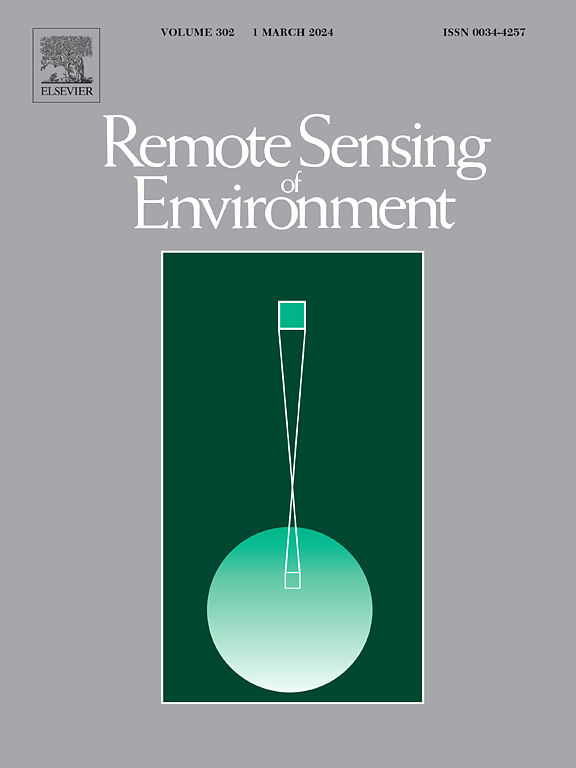Two decades of river discharge from multi-mission multispectral data
IF 11.1
1区 地球科学
Q1 ENVIRONMENTAL SCIENCES
引用次数: 0
Abstract
Long-term river discharge time series are essential for assessing water availability, seasonal variability, and the impacts of climate change. However, in-situ data do not ensure continuity and large-scale availability, as they are constrained by the limitations of monitoring networks, which are affected by high maintenance costs, geopolitical factors, and the remoteness of many river basins. Satellite remote sensing offers a valuable alternative, with multispectral data providing information on river discharge dynamics. Nevertheless, also satellite data suffer discontinuity, being periodically decommissioned and substituted by sensors with different characteristics.
This study applies and refines the Calibration-Measurement (CM) approach across 54 river sites worldwide, using 10 different multispectral satellite products from 8 satellite sensors to examine long time series of data. The methodology optimizes the selection of reflectance indices based on local hydrological conditions, evaluating the best procedure to obtain river discharge proxies according to the specific flow regimes and climatic condition. Multi-mission data are then combined to improve temporal coverage and accuracy, obtaining long-term timeseries of river discharge proxies. A new uncalibrated procedure is also introduced to extract river discharge information in sites with decommissioned stations or to obtain the CM proxies in ungauged basins.
Results demonstrate that integrating multiple satellite sources substantially improves river discharge estimation, due to factor such as the superior performance of high-resolution sensors (e.g., Sentinel-2) over coarse-resolution datasets (e.g. MODIS) in narrow rivers, and the complementary value of MODIS finer temporal resolution. The proposed merging approach enhances data consistency and reduces gaps while maintaining good performance values, while the uncalibrated method proves effective in many cases but remains challenging for frozen rivers, cloud-prone regions and areas with a low ratio between river width and satellite sensor spatial resolution. Specifically, after the application of a Cumulative Distribution Function Merging (CDF) matching to obtain river discharge estimates from CM proxies, the average and maximum value of Spearman's correlation for the calibrated approaches are respectively 0.78 and 0.92 whereas for uncalibrated approach are 0.55 and 0.89; in terms of Kling-Gupta Efficiency (KGE) the average and maximum value are 0.41 and 0.85 for calibrated approach and 0.29 and 0.8 for the uncalibrated one.
These findings highlight the potential of multi-sensor approaches for global river discharge monitoring and lay the groundwork for future operational applications.
基于多任务多光谱数据的二十年河流流量
长期河流流量时间序列对于评估水的可用性、季节变化和气候变化的影响至关重要。然而,原位数据不能保证连续性和大规模可用性,因为它们受到监测网络的限制,这些网络受到维护成本高、地缘政治因素和许多河流流域偏远的影响。卫星遥感提供了一个有价值的替代方案,多光谱数据提供了关于河流流量动态的信息。然而,卫星数据也存在不连续性,定期退役并由具有不同特性的传感器代替。本研究应用并改进了全球54个河流站点的校准测量(CM)方法,使用来自8个卫星传感器的10种不同的多光谱卫星产品来检查长时间序列数据。该方法根据当地水文条件优化了反射率指数的选择,并根据具体的流量状况和气候条件评估了获得河流流量代用指标的最佳程序。然后将多任务数据结合起来,以提高时间覆盖和精度,获得河流流量代理的长期时间序列。本文还介绍了一种新的非校准程序,用于在已关闭的站点提取河流流量信息或在未测量的流域获得CM代理。结果表明,由于高分辨率传感器(如Sentinel-2)在窄河流域的高分辨率数据集(如MODIS)上的优越性能,以及MODIS更精细时间分辨率的互补价值,多卫星源集成大大改善了河流流量估算。所提出的合并方法在保持良好性能值的同时增强了数据一致性并减少了差距,而未经校准的方法在许多情况下被证明是有效的,但对于冰冻河流,云易发地区以及河流宽度与卫星传感器空间分辨率之比较低的地区仍然具有挑战性。具体而言,采用累积分布函数合并(CDF)匹配从CM代理获取河流流量估算后,校准方法的Spearman相关平均值和最大值分别为0.78和0.92,而未校准方法的平均值和最大值分别为0.55和0.89;校正方法的KGE平均值和最大值分别为0.41和0.85,未校正方法的KGE平均值和最大值分别为0.29和0.8。这些发现突出了全球河流流量监测的多传感器方法的潜力,并为未来的操作应用奠定了基础。
本文章由计算机程序翻译,如有差异,请以英文原文为准。
求助全文
约1分钟内获得全文
求助全文
来源期刊

Remote Sensing of Environment
环境科学-成像科学与照相技术
CiteScore
25.10
自引率
8.90%
发文量
455
审稿时长
53 days
期刊介绍:
Remote Sensing of Environment (RSE) serves the Earth observation community by disseminating results on the theory, science, applications, and technology that contribute to advancing the field of remote sensing. With a thoroughly interdisciplinary approach, RSE encompasses terrestrial, oceanic, and atmospheric sensing.
The journal emphasizes biophysical and quantitative approaches to remote sensing at local to global scales, covering a diverse range of applications and techniques.
RSE serves as a vital platform for the exchange of knowledge and advancements in the dynamic field of remote sensing.
 求助内容:
求助内容: 应助结果提醒方式:
应助结果提醒方式:


